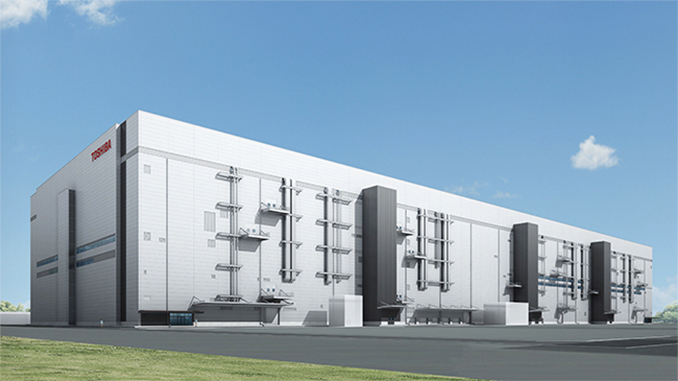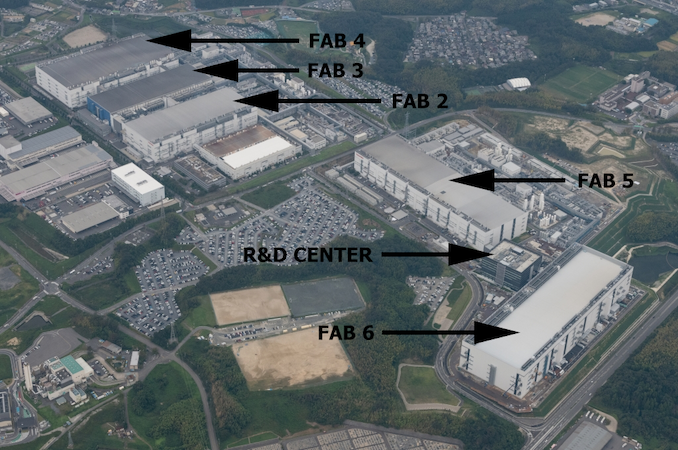Toshiba & WD NAND Production Hit By Power Outage: 6 Exabytes Lost
by Anton Shilov on June 28, 2019 12:15 PM EST
Toshiba Memory and Western Digital on Friday disclosed that an unexpected power outage in the Yokkaichi province in Japan on June 15 affected the manufacturing facilities that are jointly operated. Right now, production facilities are partially halted and they are expected to resume operations only by mid-July.
Western Digital says that the 13-minute power outage impacted wafers that were processed, the facilities, and production equipment. The company indicates that the incident will reduce its NAND flash wafer supply in Q3 by approximately 6 EB (exabytes), which is believed to be about a half of the company’s quarterly supply of NAND. Toshiba does not disclose the impact the outage will have on its NAND wafer supply in the coming months, but confirms that the fabs are partially suspended at the moment. Keeping in mind that Toshiba generally uses more capacity of the fabs than WD, the impact on its supply could be significantly higher than 6 EB with some estimating that it could be as high as ~9 EB.
Both companies are assessing the damage at the moment, so the financial harm of the incident is unclear. Not even counting potential damage to production tools and other equipment used at the fabs, 6 EB of NAND cost a lot of money. Furthermore, analysts from TrendForce believe that a consequence of the outage will be some loss of confidence from clients of both companies, which will have a financial impact as well.
The Yokkaichi Operations campus jointly owned and run by Toshiba and Western Digital produces about 35% of the global NAND output in terms of revenue, according to TrendForce. At present, the manufacturing base has five production facilities (Fab 2, Fab 3, Fab 4, Fab 5, and Fab 6) as well as an R&D center, all of which were affected by the outage. Three fabs within the campus produce 3D NAND flash, whereas another two are used to make special-purpose types of memory.
Considering the gargantuan size of the Yokkaichi Operations, disruptions of its supply will inevitably have an effect on 2D NAND and 3D NAND spot prices in the short-term future. Nonetheless, since contract prices have already been set for Q3 (and possibly Q4), they are not going to change. Meanwhile, it remains to be seen whether large customers will have to go shopping in Q3 or Q4 and affect prices on the spot markets further.
Considering that the Yokkaichi Operations produces at least 1/3 of the global NAND flash output (let’s assume that dollar share more or less corresponds to bit share) and half of its production for the quarter was lost because of the incident, this means that the industry will miss approximately 1/6 (or 16.5%) of the global NAND supply in Q3. Whether or not this will create a deficit on the market that will cause significant price hikes depends on multiple factors and is something that remains to be seen.
Related Reading
- Toshiba Memory and Western Digital Open Fab 6 and New Memory R&D Center
- Toshiba Memory & Western Digital Finalize Fab K1 Investment Agreement
- Toshiba Begins to Construct New BiCS 3D NAND Fab in Iwate Prefecture
- Toshiba Memory to Build New Fab to Produce BiCS 3D NAND
- Toshiba Finalizes Plans for New 3D NAND Fab: Coming Online in 2019
- Toshiba to Build New Fab to Produce BiCS NAND Flash
Sources: Western Digital, Reuters, TrendForce, Blocks & Files












148 Comments
View All Comments
mat9v - Sunday, June 30, 2019 - link
And how much time do you need to safely halt production?Or is that, that someone did not flip the switch hoping for power to be restored in moments and safety systems did not engage?
Or these fabs really created in such a flawed way that simple power outage will destroy months of work even with all emergency systems and protocols in place and operational?
Do they really only depend on insurance policy to cover looses?
Ananke - Monday, July 1, 2019 - link
You cannot halt production in silicon chips process. Besides, it takes days and weeks for a full process to complete.This Yokkaichi site probably uses 500-600 MWs - this power generation requires two large GE turbines /if gas electric power plant or a nuclear reactor is used :) :)/ plus reserve power of the same magnitude. Such turbines need several hours for start up time, and more than 24 hrs of reaching optimal condition, i.e. no power generators can help.
Regardless, the memory industry is happy - accident will cause jump of prices to sustainable levels, memory prices went to down - everybody was on freeze since January - no capital expenditures, no hire, no budget increases, 25% furloughs etc. This will help for years to come.
magreen - Monday, July 1, 2019 - link
@Ananke. Thanks for the clear explanation. Nice to hear a straightforward answer from someone who knows what s/he's talking about.mat9v - Tuesday, July 2, 2019 - link
Ok, it seems I was mistaken after all:http://energyskeptic.com/2014/interdependent-chip-...
"Fab plants use up to 60 megawatts of power"
Oh well, it is strange that so much power is required since the lasers lithography actually use are so weak (250W).
azazel1024 - Tuesday, July 2, 2019 - link
Better numbers than I found, thanks Mat9v. 60mw, is a lot. But it isn't an obscene amount. Ananke, as another commenter noted, many critical sites such as this produce their own power interfaced with the grid. It isn't terribly efficient, but it provides completely redundancy. That power is filtered so spike and sags are cleaned up, fluctuations in frequency, etc. If the campus power generation failed, it is grid tied and the fail over is to the grid, which can react in seconds (meanwhile the sagging voltage generated by throwing 60mw on to the local/regional grid during that time is filtered and supported by the on campus power filtering equipment, so the campus wouldn't see the voltage sag).Or at least that SHOULD be how it is done. Obviously something went badly wrong, but you can see the power plant on the campus in the picture. They have one. They just either didn't have it online, or they were using it as backup and the grid as primary and whatever they had running for intermittent grid disconnection didn't support the campus power requirements until their power plant came up (IE bad design/no testing/no sufficient layers of backups).
azfacea - Friday, June 28, 2019 - link
yes i think thats why uss ronald reagon runs on tesla supplied batteries. oh wait.cmon u can't be serious in asserting that a 13 minute power outage in japan is so rare or so expensive to deal with, that they just planned to live with it
voicequal - Friday, June 28, 2019 - link
Obviously the generators failed to start or the control systems failed.Santoval - Saturday, June 29, 2019 - link
Generators do not turn on instantly. Hell, even batteries do not start providing power instantly. Even if they are super speedy batteries which less than 1 second to start providing power that's long enough to wreck everything running. Super/ultracapacitors are required for nearly instant (<1 ms) emergency power delivery.But these have low energy capacity, so my guess is that they might be employed to provide an "energy burst" for that first 0.5 to 1 sec, and then hand over the power delivery to the batteries. The batteries, in turn, can hand the power delivery to generators after a few minutes.
I have no idea if this a viable scheme though. Instead of employing a set of supercapacitors, batteries and generators of enormous size and mass just for emergency power, it might make more sense -and cost almost the same- to build a dedicated mini power plant on-site. Ideally it should require barely any maintenance and a skeleton staff, i.e something like a solar farm along with some other power source (like wind) for the solar downtime.
It could be for emergency power and the rest of the time its power could be sold back to the grid - or as the main power source with the grid acting as backup power, depending on which option was more favorable.
Ej24 - Sunday, June 30, 2019 - link
Pretty sure I remember reading that new huge Tesla battery in Australia can kick on and provide power to the grid and stabilize voltage on the order of milliseconds. Like 50 milliseconds or less. So pretty sure these smart guys that designed such a fab would probably have something equivalent in place.Jedi2155 - Friday, July 5, 2019 - link
@Ej24 - That type of technology is relatively new TBH. Most battery control systems I've worked with have much slower control loops in the order of hundreds or thousands of ms due to their industrial background of most of the systems. Tesla however used repurposed vehicle control systems which have much faster control loops which is why Tesla has a moat there.